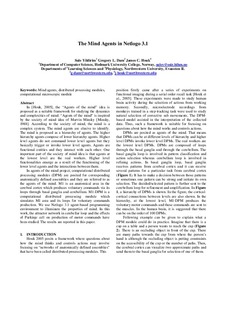The Mind Agents in Netlogo 3.1
Lecture
Permanent lenke
http://hdl.handle.net/11250/134755Utgivelsesdato
2007Metadata
Vis full innførselSammendrag
In [Houk, 2005], the “Agents of the mind” idea is proposed as a suitable framework for studying the dynamics and complexities of mind. “Agents of the mind” is inspired by the society of mind idea of Marvin Minsky [Minsky, 1988]. According to the society of mind, the mind is a complex system. The mind agents are elusive to identify. The mind is proposed as a hierarchy of agents. The higher hierarchy agents compose of lower hierarchy agents. Higher level agents do not command lower level agents but they basically trigger or invoke lower level agents. Agents are functional entities and they interact with each other. One important part of the society of mind idea is that agents at the lowest level are the real workers. Higher level functionalities emerge as a result of the functioning of the lower level agents and the interactions between them. In agents of the mind project, computational distributed processing modules (DPM) are posited for corresponding anatomically defined assemblies and they are referred to as the agents of the mind. M1 is an anatomical area in the cerebral cortex which produces voluntary commands via its loops through basal ganglia and cerebellum. M1-DPM is a computational distributed processing module which simulates M1 area and its loops for voluntary commands production. We use Netlogo 3.1 agent-based programming environment to illuminate the properties of mind. In this work, the attractor network in cerebellar loop and the effects of Purkinje cell on production of motor commands have been studied. The results are reported in this paper.
